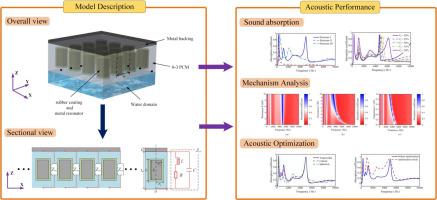Tunable underwater sound absorption via piezoelectric materials with local resonators
IF 7.1
1区 工程技术
Q1 ENGINEERING, MECHANICAL
International Journal of Mechanical Sciences
Pub Date : 2024-11-08
DOI:10.1016/j.ijmecsci.2024.109812
引用次数: 0
Abstract
In recent years, piezoelectric composite materials have been widely used in the design of underwater anechoic coatings due to their adaptability to tuning parameters. However, there are also some shortcomings, such as a single dissipation mechanism, narrow bandwidth, and poor low-frequency sound absorption. This work proposes an acoustic composite structure combining piezoelectric composite materials with local resonance units, which effectively enhances the sound absorption performance of the structure through the coupling effect of the piezoelectric energy consumption mechanism and local resonance mechanism. Compared to conventional acoustic structures, the proposed acoustic composite structure not only has a strong low-frequency sound absorption effect but also enriches the mid-high frequency sound absorption modes by connecting shunt damping circuits. On this basis, the effect of piezoelectric parameters and resonator morphological properties on structural sound absorption performance is further investigated, and the results show that the designed structure has the characteristic of sound absorption performance that is tunable. In addition, key factors affecting the sound absorption performance of the structure have been optimized to achieve better broadband sound absorption performance. This work may provide valuable ideas for the development of low-frequency broadband adjustable underwater sound-absorbing coatings.

通过带局部谐振器的压电材料实现可调水下吸声
近年来,压电复合材料因其对调谐参数的适应性强,被广泛应用于水下消声涂层的设计中。但也存在一些缺点,如耗散机制单一、带宽窄、低频吸声效果差等。本研究提出了一种压电复合材料与局部共振单元相结合的声学复合结构,通过压电耗能机制与局部共振机制的耦合效应,有效提升了结构的吸声性能。与传统声学结构相比,所提出的声学复合结构不仅具有较强的低频吸声效果,而且通过连接并联阻尼电路,丰富了中高频吸声模式。在此基础上,进一步研究了压电参数和谐振器形态特性对结构吸声性能的影响,结果表明所设计的结构具有吸声性能可调的特点。此外,还对影响结构吸声性能的关键因素进行了优化,以获得更好的宽带吸声性能。这项工作可为开发低频宽带可调水下吸声涂层提供有价值的思路。
本文章由计算机程序翻译,如有差异,请以英文原文为准。
求助全文
约1分钟内获得全文
求助全文
来源期刊

International Journal of Mechanical Sciences
工程技术-工程:机械
CiteScore
12.80
自引率
17.80%
发文量
769
审稿时长
19 days
期刊介绍:
The International Journal of Mechanical Sciences (IJMS) serves as a global platform for the publication and dissemination of original research that contributes to a deeper scientific understanding of the fundamental disciplines within mechanical, civil, and material engineering.
The primary focus of IJMS is to showcase innovative and ground-breaking work that utilizes analytical and computational modeling techniques, such as Finite Element Method (FEM), Boundary Element Method (BEM), and mesh-free methods, among others. These modeling methods are applied to diverse fields including rigid-body mechanics (e.g., dynamics, vibration, stability), structural mechanics, metal forming, advanced materials (e.g., metals, composites, cellular, smart) behavior and applications, impact mechanics, strain localization, and other nonlinear effects (e.g., large deflections, plasticity, fracture).
Additionally, IJMS covers the realms of fluid mechanics (both external and internal flows), tribology, thermodynamics, and materials processing. These subjects collectively form the core of the journal's content.
In summary, IJMS provides a prestigious platform for researchers to present their original contributions, shedding light on analytical and computational modeling methods in various areas of mechanical engineering, as well as exploring the behavior and application of advanced materials, fluid mechanics, thermodynamics, and materials processing.
 求助内容:
求助内容: 应助结果提醒方式:
应助结果提醒方式:


